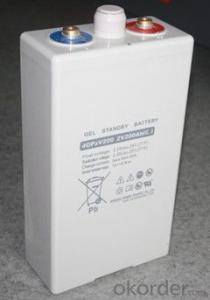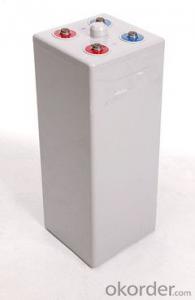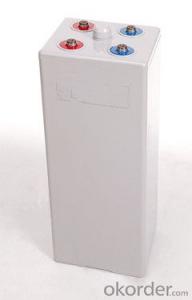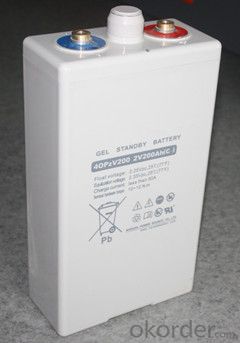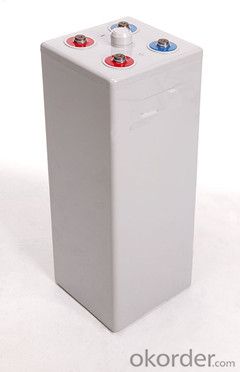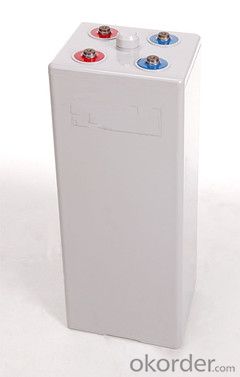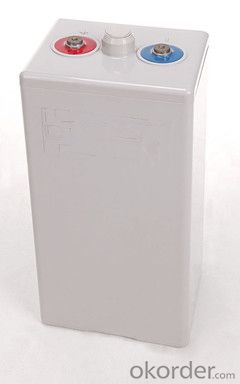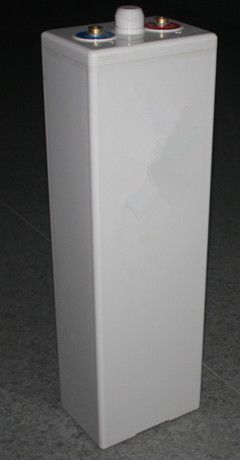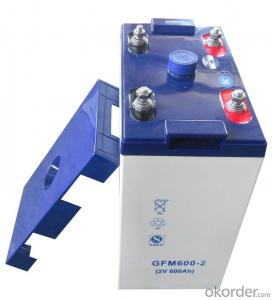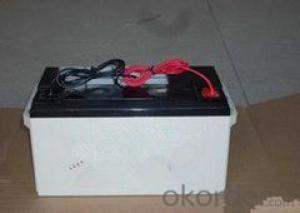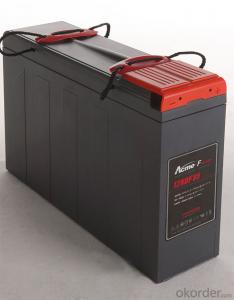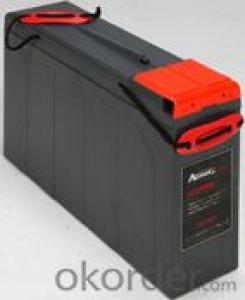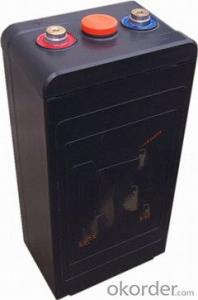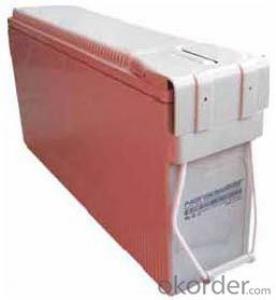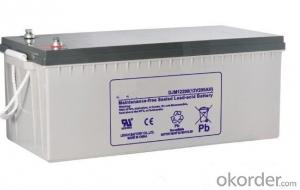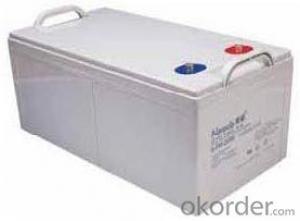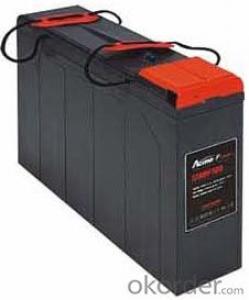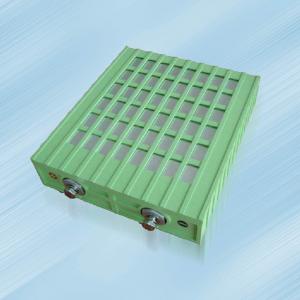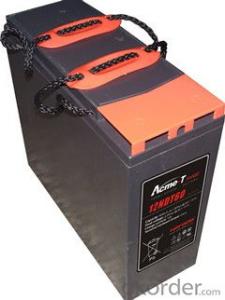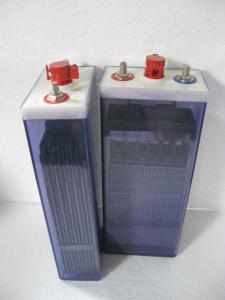Gel Technology Battery Ares(OPzV) Series 4OPzV 200
- Loading Port:
- Shanghai
- Payment Terms:
- TT OR LC
- Min Order Qty:
- 1000 unit
- Supply Capability:
- 5000000 unit/month
OKorder Service Pledge
OKorder Financial Service
You Might Also Like
Gel Technology Battery Ares(OPzV) Series Introduction
Ares(OPzV) range battery adopts traditional gel technology .
The products are designed as standby power for communication, power, military and broadcast and television system with excellent deep cycle performance. The design float life is 18+ at 77oF(25oC)
The Ares(OPzV) range batteries are ensured the quality with NARADA's QA system according to the ISO9001 and ISO14001 standard.
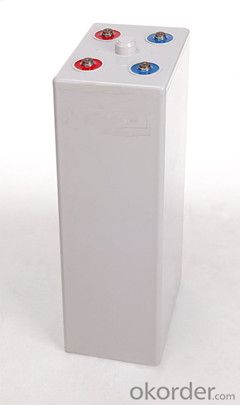
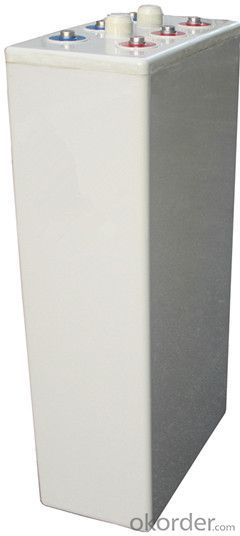
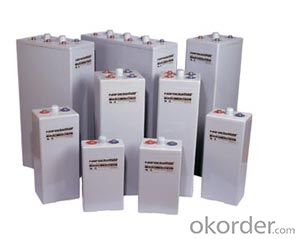
Type: | 4OPzV 200 | |
Voltage: | 2V | |
Nominal Capacity: | 200Ah(C10) | 200Ah(10 hours rate:) |
Length: | 103mm | |
Width: | 206mm | |
Height: | 356mm | |
Height with termial: | 389mm | |
Weight: | 20Kg |
Gel Technology Battery Ares(OPzV) Series Technical Feature:
Traditional gel technology
18+ years design life under floating application and cycle life is above 1200 at 80% DOD under temperature 25 oC.
Reliable seal performance, no acid spillage, recombination efficiency reach 99.9%
Initial capacity above 100%, the remaining capacity above 94% after storage for 3 months (25oC)
low float charge voltage. design (2.23V/cell, 25oC), extremely consistent float charge voltage
Flexible connectors and convenient installation
Gel Technology Battery Ares(OPzV) Series Compliant Standards :
IEC60896-21/22
Din standard
UL
Manufactured under system ISO9001(TUV) and ISO14001(DNV) by Narada
Gel Technology Battery Ares(OPzV) Series Battery Installation Compliant with:
EN 50272-2 or local equivalents
Gel Technology Battery Ares(OPzV) Series Main Application:
Telecommunications
Motive power applications
Railway and mining markets
Uninterruptible power supply (UPS)
Solar energy storage application
Other applications to provide integrated stored energy system
Gel Technology Battery Ares(OPzV) Series Products Characteristics:
Recommended float charge voltage for 2V battery: 2.23Vpc at 25oC(77oF)
Self discharge rate :< 2% per month at 25oC(77oF)
Design life: 18+ years at 25oC(77oF)
Shelf life: 6 months at 25oC(77oF)
Valve regulated system, no water addition needed
FAQ
![]() What is sulfation of batteries?
What is sulfation of batteries?
Sulfation is the formation or deposit of lead sulfate on the surface and in the pores of the active material of the batteries' lead plates. If the sulfation becomes excessive and forms large crystals on the plates, the battery will not operate efficiently and may not work at all. Common causes of battery sulfation are standing a long time in a discharged condition, operating at excessive temperatures, and prolonged under or over charging.
![]() How long a battery can last?
How long a battery can last?
The service design life of a battery are vary considerably with how it is used, how it is maintained and charged, temperature, and other factors.
![]() Do batteries self-discharge when not in use?
Do batteries self-discharge when not in use?
All batteries, regardless of their chemistry, self-discharge. The rate of self-discharge depends both on the type of battery and the storage temperature the batteries are exposed to. However, for a good estimate, Narada batteries self-discharge approximately 4% per week at 80ĄăF.
- Q: How to repair the battery?
- Connect the positive and negative output of the repair instrument to the positive and negative pole of the battery, open the repair instrument, repair the battery. The first repair time should be no less than 48 hours.
- Q: What is the difference between a maintenance-free battery and a conventional battery?
- Different materials will produce a different phenomenon: the traditional battery in the course of the use of the phenomenon of liquid reduction occurs, because the antimony on the grid will pollute the sponge on the negative plate of pure lead, weakened after the full charge of the battery Electromotive force, resulting in excessive decomposition of water, a large number of oxygen and hydrogen, respectively, from the positive and negative plates to escape, so that the electrolyte reduced. With calcium instead of antimony, you can change the fully charged battery back electromotive force, reduce the overcharge current, liquid gasification rate decreases, thereby reducing the loss of electrolyte.
- Q: What are the technical parameters of the battery?
- Battery capacity is defined as ∫ t0tdt, theoretically t can be infinite, but in fact when the battery discharge is lower than the termination voltage continues to discharge, which may damage the battery, so t value is limited, the battery industry, in hours (h) Battery sustainable discharge time, feel the C24, C20, C10, C8, C3, C1 and other nominal capacity value.
- Q: How to deal with waste batteries?
- Laboratory recycling method: ordinary dry battery is cylindrical, the outer cylinder made of zinc, the zinc cylinder is the battery negative; tube central carbon rod for the positive; tube for the manganese dioxide, ammonium chloride and chlorination Zinc.
- Q: What are the hazards of battery over discharge?
- The battery discharge to the standard termination voltage when the internal resistance will become larger, the battery electrolyte concentration will become very thin, especially the battery plate micropores and battery plate surface these two points are almost neutral; battery over discharge because of Internal resistance will become larger, so the battery will appear inside the phenomenon of heat, the battery volume will appear fever expansion.
- Q: What battery does the van use?
- The most obvious feature of lead-acid batteries is the top of the plastic cover can be unscrewed, there are ventilation holes above. These fillers are used to fill pure water, check the electrolyte and the use of exhaust gas. In theory, lead-acid batteries need to check the density of each electrolyte and the level of liquid, if there is a need to add distilled water. But with the upgrading of battery manufacturing technology, lead-acid battery development for the lead-acid maintenance-free batteries and colloidal maintenance-free batteries, lead-acid batteries do not need to add electrolyte or distilled water. Mainly the use of positive electrode to produce oxygen can be absorbed in the negative oxygen cycle, to prevent water reduction. Lead-acid water batteries are mostly used in tractors, tricycles, car start, etc., and maintenance-free lead-acid battery wider range of applications, including uninterruptible power supply, electric vehicle power, electric bicycle batteries. Lead-acid batteries according to the application needs to be divided into constant current discharge (such as uninterruptible power supply) and instantaneous discharge (such as car to start the battery).
- Q: What are the advantages of maintenance-free batteries?
- Maintenance-free battery using lead-calcium alloy grille, the amount of water generated when charging less water evaporation is low, with the shell with a sealed structure, the release of sulfuric acid gas is also very little, so with the above advantages.
- Q: What kind of battery is divided into?
- Maintenance-free battery due to its own structure on the advantages of electrolyte consumption is very small, in the life of the basic need not add distilled water. It also has a shock, high temperature, small size, self-discharge characteristics of the general life is generally ordinary Twice the battery. There are two kinds of maintenance-free batteries on the market.
- Q: How does the battery increase the voltage?
- You can use the same battery in series, with 5 12v battery in series becomes 60v, if you need the current is relatively small, you can use DC-DC module to 12v voltage rise to 60v.
- Q: Lead-acid battery how to maintain?
- After passing the test, cover the exhaust cutting, pay attention to restore the filler, cover the battery cover, if the cover is glued, then glue bonding.
Send your message to us
Gel Technology Battery Ares(OPzV) Series 4OPzV 200
- Loading Port:
- Shanghai
- Payment Terms:
- TT OR LC
- Min Order Qty:
- 1000 unit
- Supply Capability:
- 5000000 unit/month
OKorder Service Pledge
OKorder Financial Service
Similar products
Hot products
Hot Searches
Related keywords
